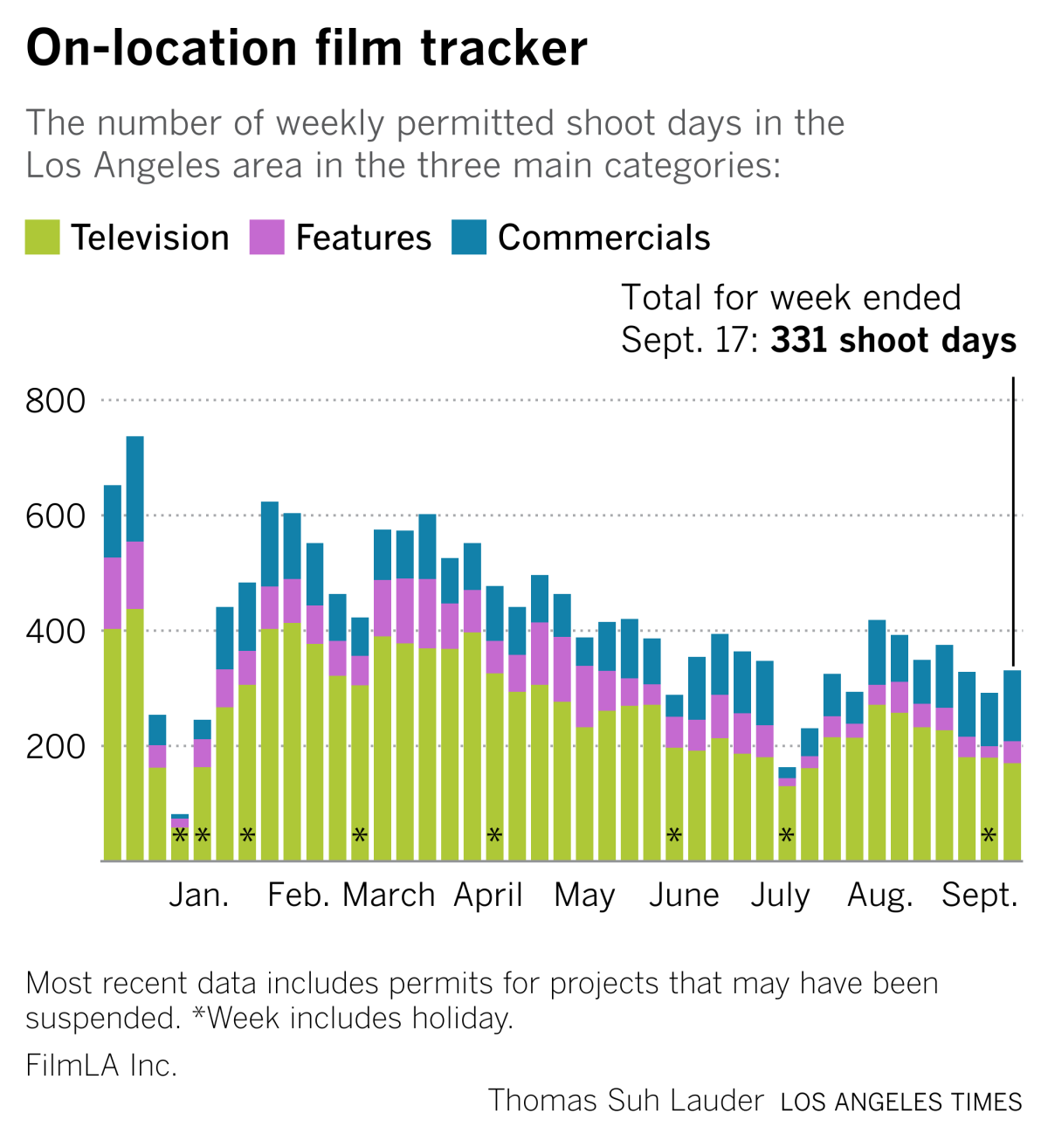What to make of Hulu and Max’s popularity rankings and the battle over data transparency

- Share via
Welcome to the Wide Shot, a newsletter about the business of entertainment. Sign up here to get it in your inbox.
Those familiar with the work of writer Nate Silver — author of the book “The Signal and the Noise” — may recognize the axiom that “data is useless without context.”
That mantra is certainly true from a statistician’s point of view, but perhaps not from that of a marketing executive or the designer of a streaming video service’s user interface.
In recent weeks, Warner Bros. Discovery’s Max (formerly HBO Max) and Walt Disney Co.-controlled Hulu have added content rankings to their apps, with the aim of telling users what others on the platforms are watching, something Netflix has done for years.
As the lists exist now, they do not offer a solution to the problem of “data transparency,” which is at the heart of a long battle writers and actors have waged against entertainment conglomerates in their quest to get paid more for the hits with which they’re involved, a debate my colleague Wendy Lee wrote about in depth last week.
Nor do they advertise themselves as such. The idea is mainly aimed at solving another issue plaguing streamers: viewers not knowing what to watch.
For overwhelmed consumers, there’s a “choice paralysis” that comes with trying to navigate the seemingly bottomless libraries available on the largest digital video services. And the rankings, which show up as carousels on the apps’ home screens, allow viewers to follow the herd to something they might enjoy.
It’s also a way for certain shows and movies to get more exposure. Never heard of Searchlight’s Ben Platt-fronted Sundance comedy “Theater Camp”? Well there it is, at No. 5 on Hulu’s rotation, as of Monday. Classic studio trick: Get viewers to watch something by telling them it’s already popular.
The differences between Max’s Top 10s and Hulu’s Top 15 (all updated daily) are interesting.
Max boasts separate Top 10 lists for movies and for series, similar to how Netflix does it. The service calculates the rankings based on the number of user profiles that watch a title, counting a view as long as the person watches for more than two minutes, like the old Netflix standard. A show or film has to be a fairly recent addition to the platform in order to hit the charts, which are country-specific.
Hulu’s Top 15 ranking, which debuted last week, is a little different because it includes movies and series together. According to Disney’s press release, its formula factors in not only raw viewing data within a 24-hour span but also “considers the growing popularity of new shows/movies released during that time frame.” Hulu’s full on-demand catalog is eligible, not just the new material.
This all happens to come as writers and actors are seeking more insight into how well their shows are performing, in order to wrangle some kind of “success-based residual” or performance bonus from streaming. Moreover, agents say, having a clearer window into performance metrics would help artists better negotiate their deals with studios, as they do with TV ratings and box office receipts.
But as Lee reported, Netflix and other streamers represented by the Alliance of Motion Picture and Television Producers, have resisted giving writers access to their numbers in a way that would satisfy guild demands.
There are a number of reasons for this reluctance. While some platforms have been happy to selectively dole out numbers to celebrate their hits, they don’t want to expose their flops.
Also, having a complete Nielsen- or Comscore-like database of raw numbers for every streaming show could make for apples-to-oranges comparisons between the big players like Netflix and the smaller ones, like Paramount+ and Peacock.
Netflix, once tagged a “black box” by some artists for its lack of forthrightness, has lately been more willing to publicly share numbers than its rivals, though certainly not as much as the WGA or SAG-AFTRA would like.
The Los Gatos, Calif.-based company abandoned the two-minute viewing threshold in favor of counting a view as total amount of time viewed divided by the length of the movie or episode.
In the pecking order of streaming data sets, daily Top 10 lists sit somewhere between raw viewership numbers and the streaming era’s pervasive “not much context, just vibes” school of statistics (14 million viewers for the first episode of “Ahsoka” on Disney+!).
But while it’s easy to laugh them off, such rankings could provide clues for a framework to solve the data and residuals question.
The WGA and the companies could come up with a framework for success-based bonuses that would reflect the fact that a hit on Netflix, with its 238 million subscribers, is different from one on Apple TV+ or Peacock.
Payments could be triggered, for example, if a show reaches a certain threshold in a streamer’s internal rankings of its original programs (if it hit the top 10, for example), using each company’s preferred metric, perhaps audited by a third party.
For viewers, the new rankings from Max and Hulu could offer some help in understanding why their favorite shows are getting canceled. There are data wonks like the Entertainment Strategy Guy and the Czech company FlixPatrol that factor in such rankings to determine whether certain shows registered with audiences.
Parrot Analytics’ Julia Alexander, in a quick analysis for Puck, observed that Max’s Top 10s lean more “populist” (more in the direction of “Young Sheldon” and “Hard Knocks”) than the prestige-focused reputation of its HBO-branded predecessor might suggest, which was part of the point of David Zaslav’s rebranding strategy. So that’s something.
But there’s nothing quite like real numbers to explain why a show like HBO’s “Winning Time,” which has dominated much of my social media feed despite mixed reviews, would be canceled after two seasons, particularly after ending with an episode in which the heroes, the Los Angeles Lakers, lose to the Boston Celtics in the 1984 NBA finals. Season 2 episodes of “Winning Time” were averaging 3.7 million viewers across Warner Bros. Discovery’s platforms, down about 33% from the 5.5 million who watched Season 1.
It’s an expensive show with a stacked cast, and airing during the NBA’s off-season and the strikes probably didn’t help.
For what it’s worth, “Winning Time” ranked third Monday on Max’s series Top 10, coming in behind the British fantasy show “A Discovery of Witches” (borrowed from AMC+) and the adult animated spinoff “Adventure Time: Fionna and Cake.” Anecdotal comparisons at best. But anyone obsessed with the Lakers and the NBA can appreciate having another stat in the box score.
Stuff we wrote
— Disney fields interest from potential ABC buyers. But ‘no decision’ to sell, company says. Walt Disney Co. CEO Bob Iger has made clear he is open to exploring deals to sell or spin off ABC and other linear television networks as the company struggles to adapt to industry headwinds. Nexstar Media Group, Byron Allen and private equity firms have expressed interest.
— Wasserman acquires talent manager Brillstein Entertainment Partners. The acquisition of Brillstein marks Wasserman’s 10th acquisition in two years and comes amid consolidation in the representation space and the strikes putting pressure on agencies and management firms.
— 5 things to know about a potential strike against video game companies. SAG-AFTRA members will vote this month on whether to authorize union leaders to call a strike against video game companies. Here’s how we got to this point.
— VFX workers at Marvel Studios unanimously vote to unionize. Visual effects workers at Marvel Studios unanimously voted to join the International Alliance of Theatrical Stage Employees, the union said.
— ICYMI. Former NFL Media journalist Jim Trotter sues league for racial discrimination. Libertarian commentator Lawrence Jones joins ‘Fox & Friends.’ WWE and UFC officially merge in $21.4-billion deal. ABC adds ‘Monday Night Football’ games as strikes bench entertainment shows. Former MPAA general counsel disbarred in New York.
Meetings meetings meetings
With talks between the WGA and the Alliance of Motion Picture and Television Producers set to resume Wednesday, it’s still too soon in the process to put much hope in an October resolution, long seen as key for studios hoping to salvage their movie and TV slates. But agreeing to meet is progress, at least compared to nothing but back-channel talks and sniping on social media.
As the ice between the sides began to show signs of thawing after a weeks-long standstill, the long-anticipated, much-debated meeting between high-profile showrunners — led by Kenya Barris and Noah Hawley — and guild leadership was canceled.
In the absence of reliable information, rumor and gossip ran as wild as an invasive species with no natural predators. Rumblings of a brewing showrunner mutiny sent the industry spiraling for days.
But sources close to talent who spoke to The Times and others threw cold water on the notion of a rift between top-tier writers and union leadership. (The Ankler had a good piece on the episode, which you could set to the theme of “The Benny Hill Show.”)
The real question is what will come from the upcoming meeting between the WGA and the AMPTP, which for weeks couldn’t even agree whose turn it was to offer counterproposals.
After a nearly monthlong standstill since a disastrous Aug. 22 meeting between the WGA and studio heads, it’s unclear what else the AMPTP is willing to concede and what kind of deal the WGA would be ready to accept other than total capitulation after all its members and other workers have sacrificed.
Film shoots
Here’s the latest data on weekly shoot permits from FilmLA. They’re not great.

Best of the web
— Erich Schwartzel has the backstory of yet another oddball Hollywood-China entanglement. How a squiggly line on a map got ‘Barbie’ banned in Vietnam. (Wall Street Journal)
— Josef Adalian asks, what if everyone won the Disney-Charter dispute? (Vulture.) For further reading, Ben Thompson breaks down the wins and losses on both sides at Stratechery.
— What is the “corporate goth” aesthetic, and is it coming to an office near you? (Fortune)
— Which talk show host had the worst week, Hasan Minhaj or Drew Barrymore? (I’m going with Minhaj.) Barrymore announced she would delay the return of her show after getting union backlash amid the strikes. Other hosts quickly followed suit.
Finally ...
One of my favorite new Twitter (ugh, X, I guess) follows is an account called bluesharp (@bluezharp), which mostly posts clips of old blues and rock ’n’ roll performers. Here’s a video of Jacob Raagaard, a brilliant musician who specializes in playing a Weissenborn lap steel guitar (hat tip to music critic Ted Gioia for retweeting this one).
The Wide Shot is going to Sundance!
We’re sending daily dispatches from Park City throughout the festival’s first weekend. Sign up here for all things Sundance, plus a regular diet of news, analysis and insights on the business of Hollywood, from streaming wars to production.
You may occasionally receive promotional content from the Los Angeles Times.




